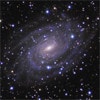One tenth of stars may support life

One tenth of the stars in our galaxy might provide the right conditions to support complex life, according to a new analysis by Australian researchers. And most of these stars are on average one billion years older than the Sun, allowing much more time, in theory, for any life to evolve.
The concept of a "galactic habitable zone" (GHZ) for the Milky Way was first proposed in 2001. Now Charles Lineweaver of the University of New South Wales and colleagues have defined a life-friendly GHZ using a detailed model of the evolution of the Milky Way to map the distribution in space and time of four major factors thought essential for complex life.
"We're looking at what we think are the most robust and conservative pre-requisites for life - but they are very, very basic," Lineweaver says.